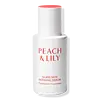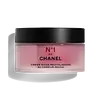What's inside
What's inside
 Key Ingredients
Key Ingredients

 Benefits
Benefits

 Concerns
Concerns

 Ingredients Side-by-side
Ingredients Side-by-side

Water
Skin ConditioningPropanediol
SolventButylene Glycol
HumectantNiacinamide
Smoothing1,2-Hexanediol
Skin ConditioningPrunus Persica Fruit Extract
AbrasiveDioscorea Japonica Root Extract
Skin ConditioningSodium Hyaluronate
HumectantAdenosine
Skin ConditioningHydrolyzed Sodium Hyaluronate
Skin ConditioningMadecassoside
AntioxidantHydrolyzed Hyaluronic Acid
HumectantSodium Acetylated Hyaluronate
HumectantAcetyl Octapeptide-3
HumectantEthylhexylglycerin
Skin ConditioningHydrolyzed Corn Starch
HumectantSodium Carbomer
Emulsion StabilisingBeta-Glucan
Skin ConditioningSaccharide Isomerate
HumectantPhytic Acid
Sucrose
HumectantAsiaticoside
AntioxidantCaprylyl Glycol
EmollientWater, Propanediol, Butylene Glycol, Niacinamide, 1,2-Hexanediol, Prunus Persica Fruit Extract, Dioscorea Japonica Root Extract, Sodium Hyaluronate, Adenosine, Hydrolyzed Sodium Hyaluronate, Madecassoside, Hydrolyzed Hyaluronic Acid, Sodium Acetylated Hyaluronate, Acetyl Octapeptide-3, Ethylhexylglycerin, Hydrolyzed Corn Starch, Sodium Carbomer, Beta-Glucan, Saccharide Isomerate, Phytic Acid, Sucrose, Asiaticoside, Caprylyl Glycol
Camellia Japonica Flower Water
Skin ConditioningWater
Skin ConditioningGlycerin
HumectantMoringa Oil/Hydrogenated Moringa Oil Esters
Skin ConditioningOctyldodecyl Myristate
EmollientCetearyl Alcohol
EmollientCamellia Oleifera Seed Oil
Skin ConditioningBehenyl Alcohol
EmollientCamellia Japonica Seed Oil
EmollientPentaerythrityl Stearate/Caprate/Caprylate/Adipate
EmollientVegetable Oil
Skin ConditioningPanthenol
Skin ConditioningPropanediol
SolventFaex
Skin ConditioningCamellia Japonica Flower Extract
EmollientCeramide NP
Skin ConditioningPhytosphingosine
Skin ConditioningCetearyl Glucoside
EmulsifyingPentylene Glycol
Skin ConditioningCarbomer
Emulsion StabilisingGlyceryl Stearate Se
EmulsifyingSodium Stearoyl Glutamate
CleansingParfum
MaskingChlorphenesin
AntimicrobialCaprylyl Glycol
EmollientCamelina Sativa Seed Oil
Skin ConditioningSodium Hydroxide
BufferingSodium Hyaluronate
HumectantAdenosine
Skin ConditioningPentaerythrityl Tetra-Di-T-Butyl Hydroxyhydrocinnamate
AntioxidantLactic Acid
Buffering1,2-Hexanediol
Skin ConditioningPhytic Acid
Hydrogenated Lecithin
EmulsifyingTocopherol
AntioxidantSodium Citrate
BufferingPalmitoyl Tetrapeptide-7
Skin ConditioningSodium Benzoate
MaskingCitric Acid
BufferingCamellia Japonica Flower Water, Water, Glycerin, Moringa Oil/Hydrogenated Moringa Oil Esters, Octyldodecyl Myristate, Cetearyl Alcohol, Camellia Oleifera Seed Oil, Behenyl Alcohol, Camellia Japonica Seed Oil, Pentaerythrityl Stearate/Caprate/Caprylate/Adipate, Vegetable Oil, Panthenol, Propanediol, Faex, Camellia Japonica Flower Extract, Ceramide NP, Phytosphingosine, Cetearyl Glucoside, Pentylene Glycol, Carbomer, Glyceryl Stearate Se, Sodium Stearoyl Glutamate, Parfum, Chlorphenesin, Caprylyl Glycol, Camelina Sativa Seed Oil, Sodium Hydroxide, Sodium Hyaluronate, Adenosine, Pentaerythrityl Tetra-Di-T-Butyl Hydroxyhydrocinnamate, Lactic Acid, 1,2-Hexanediol, Phytic Acid, Hydrogenated Lecithin, Tocopherol, Sodium Citrate, Palmitoyl Tetrapeptide-7, Sodium Benzoate, Citric Acid
 Reviews
Reviews

Ingredients Explained
These ingredients are found in both products.
Ingredients higher up in an ingredient list are typically present in a larger amount.
1,2-Hexanediol is a synthetic liquid and another multi-functional powerhouse.
It is a:
- Humectant, drawing moisture into the skin
- Emollient, helping to soften skin
- Solvent, dispersing and stabilizing formulas
- Preservative booster, enhancing the antimicrobial activity of other preservatives
Adenosine is in every living organism. It is one of four components in nucleic acids that helps store our DNA.
Adenosine has many benefits when used. These benefits include hydrating the skin, smoothing skin, and reducing wrinkles. Once applied, adenosine increases collagen production. It also helps with improving firmness and tissue repair.
Studies have found adenosine may also help with wound healing.
In skincare products, Adenosine is usually derived from yeast.
Learn more about AdenosineCaprylyl Glycol is a humectant and emollient, meaning it attracts and preserves moisture.
It is a common ingredient in many products, especially those designed to hydrate skin. The primary benefits are retaining moisture, skin softening, and promoting a healthy skin barrier.
Though Caprylyl Glycol is an alcohol derived from fatty acids, it is not the kind that can dry out skin.
This ingredient is also used as a preservative to extend the life of products. It has slight antimicrobial properties.
Learn more about Caprylyl GlycolPhytic Acid is a gentle AHA and antioxidant. AHAs are chemical exfoliants that help remove dead skin cells. Phytic Acid has a slight and mild exfoliating effect.
The chemical makeup makes it classified as an AHA, much like lactic acid.
In some cases, it is a chelating agent. Chelating agents help prevent metals from binding to water, helping to stabilize the ingredients in a product.
An interesting fact about phytic acid is that it is considered an antinutrient. People do not have the enzyme needed to properly breakdown and digest phytic acid. When ingested, phytic acid binds to minerals and prevents them from being absorbed.
Read more about some other popular AHA's here:
Learn more about Phytic AcidPropanediol is an all-star ingredient. It softens, hydrates, and smooths the skin.
It’s often used to:
Propanediol is not likely to cause sensitivity and considered safe to use. It is derived from corn or petroleum with a clear color and no scent.
Learn more about PropanediolSodium Hyaluronate is hyaluronic acid's salt form. It is commonly derived from the sodium salt of hyaluronic acid.
Like hyaluronic acid, it is great at holding water and acts as a humectant. This makes it a great skin hydrating ingredient.
Sodium Hyaluronate is naturally occurring in our bodies and is mostly found in eye fluid and joints.
These are some other common types of Hyaluronic Acid:
Learn more about Sodium HyaluronateWater. It's the most common cosmetic ingredient of all. You'll usually see it at the top of ingredient lists, meaning that it makes up the largest part of the product.
So why is it so popular? Water most often acts as a solvent - this means that it helps dissolve other ingredients into the formulation.
You'll also recognize water as that liquid we all need to stay alive. If you see this, drink a glass of water. Stay hydrated!
Learn more about Water